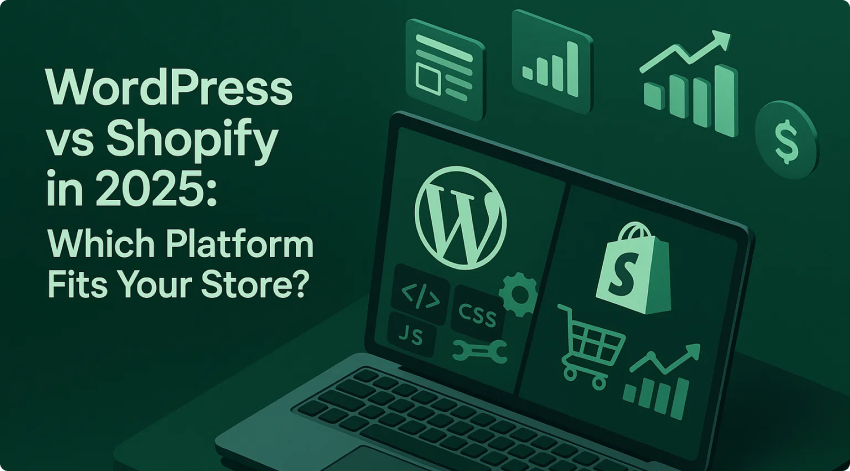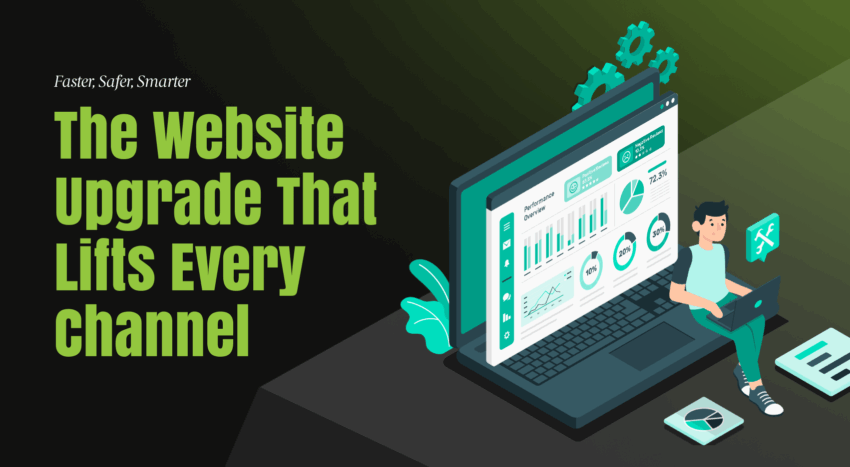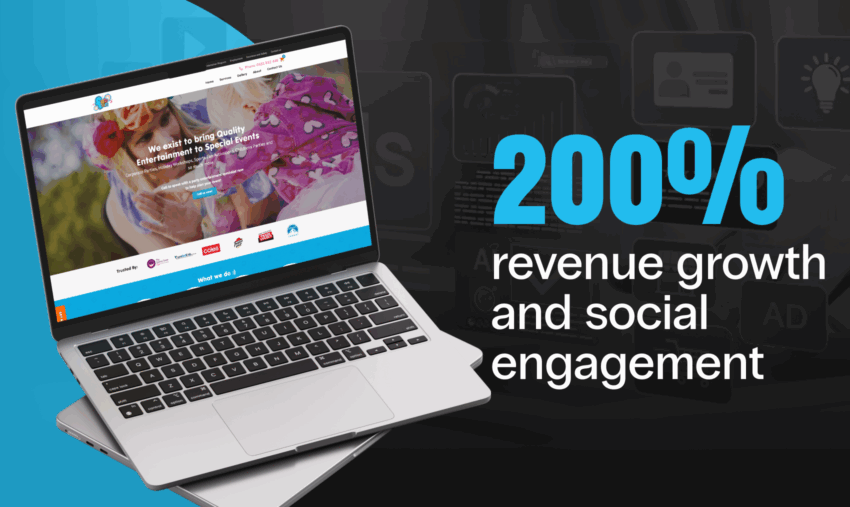WordPress vs Shopify in 2025: Which Platform Fits Your Store?

TL;DR – Key Takeaways
- Shopify: Best for beginners and fast launches; predictable pricing but higher long-term costs.
- WordPress + WooCommerce: Best for flexibility, customisation, and SEO; requires more hands-on management.
- Costs: Shopify charges monthly fees plus transaction costs; WordPress is cheaper upfront but it depends on hosting and maintenance.
- Scalability: Shopify scales seamlessly out of the box; WordPress can scale well but demands technical oversight.
- Content & SEO: WordPress leads for content-heavy or SEO-driven businesses; Shopify offers solid but more limited tools.
The Platform Dilemma in 2025
Every business owner faces the same dilemma: Do you choose the polished, ready-to-run solution or the flexible, customisable foundation?
In ecommerce, that usually comes down to Shopify vs. WordPress with WooCommerce. They’re both proven and powerful, but they suit very different growth paths.
Think of it this way: Shopify is like renting a modern apartment. Everything works out of the box, but you can’t knock down walls. WordPress is like owning the land. You can build your dream home, but you’ll need the right builders to get it right.
From here, the real question is how each platform stacks up against the things that matter most: cost, usability, features, SEO, and growth potential.
Shopify in a Nutshell: Convenience at a Cost

Shopify is designed for speed and simplicity. You sign up, pick a theme, add products, and you’re ready to sell. Hosting, security, and checkout are bundled in, which means fewer moving parts for you to worry about. This simplicity is often the most significant selling point for businesses exploring Shopify development.
That ease of use is what makes Shopify so attractive. Business owners can launch quickly, plug in new tools through their app marketplace, and rely on 24/7 customer support.
But convenience isn’t free. Monthly subscriptions rise quickly when you add apps, transaction fees eat into margins, and while you can customise to a point, you’ll always be working inside Shopify’s guardrails.
Many Australian merchants choose Shopify Payments Australia to avoid extra transaction fees, limiting gateway flexibility.
WordPress with WooCommerce: Flexibility Meets Responsibility

WordPress powers over 40% of the web globally, and Forbes has reported that WooCommerce is one of the most widely adopted ecommerce add-ons worldwide. Today, it powers more than 4.6 million active stores worldwide, underscoring its dominance as the go-to plugin for ecommerce flexibility.
Unlike Shopify, you own the code and hosting environment, giving you almost limitless control. Many businesses that want this level of adaptability invest in WordPress development to create a site that can scale with their needs.
The catch? Responsibility. You’re responsible for hosting, updates, plugin compatibility, and security. When managed well with reliable providers, WordPress scales beautifully. For ecommerce in particular, WooCommerce development unlocks the advanced functionality needed to compete with dedicated platforms like Shopify.
Counting the Costs: What You’ll Really Pay in 2025
Budget is often the deciding factor when choosing an ecommerce platform. Beyond headline subscription prices, ongoing expenses such as apps, plugins, hosting, and transaction fees shape the true cost of ownership.
- Shopify: Plans start at around AUD $56/month and climb to $463+. Add transaction fees (up to 2% without Shopify Payments) and paid apps ($10–$100 each), and the monthly spend can grow quickly.
- WordPress: Hosting costs $10–$50/month, premium themes cost $50–$100, and plugins may cost $50–$300 annually. Development and maintenance are variable, but fixed subscription fees are avoided.
Shopify is predictable but often pricier over time. WordPress can be leaner, provided you manage hosting and updates effectively. The difference is apparent in a detailed analysis from SEMrush, which shows how quickly add-ons and apps can inflate monthly budgets.
Ease of Use vs Total Control
The right choice will depend on how much time and effort you can dedicate to managing your store. Shopify prioritises simplicity, while WordPress rewards those willing to take on more responsibility for deeper control.
- Shopify’s strength: accessibility. It guides you through setup, handles hosting, and keeps technical details hidden. That’s perfect if you want to sell quickly without technical hurdles.
- WordPress’s strength: control. It takes longer to get right, but it rewards you with unmatched flexibility. You can optimise site speed, fine-tune user experience, and extend functionality endlessly with plugins or custom code.
If your team is lean and you want to focus on sales, Shopify is usually the smoother ride. If you have technical resources (or the right partner), WordPress offers more room to grow on your own terms.
Design & Customisation: How Much Freedom Do You Need?
How your store looks and feels significantly affects customer trust and conversion rates. While both Shopify and WordPress can deliver a professional storefront, they take very different approaches to customisation.
- Shopify: Polished themes, mobile-friendly layouts, and drag-and-drop editing. You’ll get a professional store quickly, but customisation has limits.
- WordPress: Thousands of themes and unlimited customisation. This flexibility matters for businesses where brand experience and unique UX are part of the value proposition.
Zapier compares Shopify’s simplicity and WordPress’s creative freedom in depth, highlighting how each platform balances ease of use with creative control.
Ecommerce Features That Matter in 2025
Both platforms cover essentials, including product listings, carts, and checkout. The differences lie in what’s built-in versus what requires plugins.
|
Feature |
Shopify |
WordPress + WooCommerce |
|
Abandoned Cart Recovery |
Built-in |
Requires plugin |
|
Multi-Channel Selling |
Native integrations with Facebook, Instagram, TikTok, and Amazon |
Available via plugins |
|
Payment Gateways |
100+ options, extra fees for third-party gateways |
Wide range via plugins, no extra fees |
|
BNPL (Afterpay, Zip, Klarna) |
Direct integrations |
Plugin-based integrations |
Who Wins the SEO Battle?
WordPress remains the frontrunner for SEO. Plugins like Yoast and RankMath give you control over metadata, URLs, schema, and content optimisation. Its strong blogging tools make it the obvious choice for content-driven strategies.
Shopify has improved, with faster themes, built-in structured data, and strong mobile optimisation. However, some structural limitations, like rigid URL formats, still hold it back. For competitive industries, WordPress usually has the edge. Shopify’s growth still shows its relevance, with Yaguara reporting that it now powers over 5.6 million active stores globally, making it one of the most widely adopted ecommerce platforms.
Scaling Up: Performance, Security, and Growth
Growth brings new challenges, from handling higher traffic volumes to securing data. Both Shopify and WordPress can scale, but they take very different approaches to reliability and oversight.
- Shopify: Hosting and security are managed. It handles traffic spikes and checkout surges with minimal input.
- WordPress: Performance depends on your hosting and configuration. With the proper infrastructure (CDN, caching, firewalls), it scales well but demands active oversight.
Support: Who’s Got Your Back?
When issues arise, and they always do in ecommerce, support can make or break your experience. The way Shopify and WordPress handle customer service is one of their most important differentiators.
- Shopify: 24/7 customer support with instant assistance.
- WordPress: No single helpdesk. Instead, you rely on community forums, freelancers, or agencies. In Australia, an experienced WordPress development team can provide dependable long-term support. For many businesses, exploring ecommerce website development options is the best way to decide which model fits their needs.
Shopify vs WordPress: The Quick Snapshot

If you don’t have time to dig into every detail, here’s a condensed overview of how the two platforms compare at a glance:
|
Platform |
Pros |
Cons |
|
Shopify |
Easy to use, reliable hosting, built-in ecommerce tools, 24/7 support |
Higher monthly costs, transaction fees, and limited customisation |
|
WordPress + WooCommerce |
Total control, powerful SEO, flexible design, strong content tools |
Hosting/maintenance required, more technical to manage |
Shopify vs WordPress FAQs
Can I migrate between Shopify and WordPress without losing SEO?
Yes, but it requires careful planning. Use 301 redirects and watch for URL structure differences. Done correctly, rankings can be preserved.
Which platform handles extensive product catalogues better?
Shopify’s hosted infrastructure smoothly handles large catalogues. WordPress can scale, too, but only with optimised hosting and database tuning.
How do payment processing fees differ in Australia?
Shopify adds up to 2% extra for third-party gateways. WordPress doesn’t add platform fees, so you only pay standard rates (around 1.75% + $0.30 locally).
Which is stronger for content-heavy businesses?
WordPress remains the stronger choice for publishers, educators, and content-led brands.
How do security responsibilities compare?
Shopify manages PCI compliance automatically. WordPress requires you to stay on top of updates and plugin vetting.
Which platform is more future-proof?
Shopify seamlessly pushes global updates. WordPress adapts more slowly but allows cutting-edge models like headless commerce solutions if you have the resources.
Which platform is easier to maintain with a small team?
Shopify is generally less resource-intensive because everything is bundled. WordPress requires hosting management, updates, and monitoring, which may demand outside help if your team is limited.
The Bottom Line: Choosing a Platform That Fuels Growth
Shopify offers speed and convenience, while WordPress offers control and flexibility. Both can support a thriving ecommerce store. The only difference is which model best fits your growth strategy and resources.
If you’re weighing up your web development options in 2025, Click Click Media can help. We don’t just build stores; we mentor, guide, and stay hands-on as your growth partner. Whether you want fast-to-market simplicity or long-term SEO strength, we’ll help you choose what fuels sustainable growth.



